If you are running a WordPress website or blog in which you’ve given two or more people admin rights, you, as an owner, must set up two-factor authentication. In another scenario, if anyhow your WordPress password is leaked in a data breach or anyone guessed it, the two-factor authentication will still restrict hackers from logging into your website.
So, if you want to make your WordPress blog or website even more secure than ever before, two-factor authentication (2FA) is a smart move.
2FA is no longer a “nice-to-have” feature. It’s essential these days to keep your website safe from hackers and malicious attacks. With 2FA, even if someone gets access to your password, they still need a second verification, like a code sent to your phone, to log in. This additional step makes it nearly impossible for hackers to gain access without your permission.
But, when the concern is about securing our website, everyone wants to use the best and most secure 2FA plugin to secure the WordPress website. In this article, I’ve come up with the 4 best 2FA WordPress plugins on your website. Whether you’re looking for a lightweight option or a full security suite, these plugins will help you add that much-needed extra layer of protection.
The Best 2FA WordPress Plugins
There are many two-factor authentication plugins available for WordPress websites. I have tested over 10 of them. Among those 10 2FA WordPress plugins, I filtered out the 4 best of them based on their ease of use, pros, and cons. Let’s check them out below.
-
Best 2FA WordPress Plugin: miniOrange 2-Factor Authentication
-
Best Alternative to miniOrange 2FA: WP 2FA Plugin
-
Best All-in-One Security Plugin with 2FA: Wordfence
1. Wordfence Security
Wordfence is one of the must-have WordPress plugins to secure your website. It’s not just for two-factor authentication but provides complete website security through firewall and malware scan.
When it comes to WordPress website security, Wordfence comes as an all-in-one solution for different security needs. It provides different security solutions including Google reCaptcha, 2FA, etc. to safeguard your WordPress website login.
I have been using the Wordfence Security plugin for more than 5 years on my different blogs. I personally found it very simple to set up two-factor authentication using the Wordfence Security plugin.
Here’s How to Setup 2FA Using Wordfence
First of all, install the Wordfence Security plugin on your WordPress blog or website. After installation, it will ask you to get your Wordfence license. Just click that “Get Your Wordfence License” button and choose to get a free license if you are not willing to go with the paid version now. After following the instructions, you’ll get a free Wordfence license on your email. Finally, complete your Wordfence installation by using that free license key.

Once you’ve completed your installation, navigate to Wordfence > Login Security through your WordPress dashboard. On the Login Security page, you will find a Two-Factor Authentication tab.
On this tab, you will see a QR code that you will have to scan through a TOTP-based app like Google Authenticator, Authy, etc. So, after installing the authenticator app on your smartphone, it’s a two-step process.
- Scan the QR code using the authenticator app.
- You will get a code in your authenticator application that you will have to enter in your 2FA tab on your WordPress dashboard.
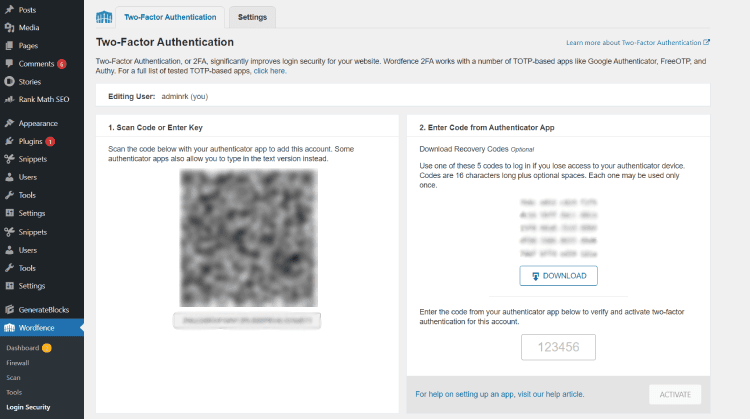
That’s it. Just click the Activate button on the Two-Factor Authentication tab and it’s done. This is how you can easily activate 2FA on your WordPress website through the Wordfence Security plugin.
Pros
-
Offers firewall protection, malware scanning, and more with 2FA.
-
Comes with the brute force protection feature.
-
Supports many authenticator apps like Google Authenticator, Authy, etc.
-
Setting up 2FA using Wordfence is the easiest process ever.
-
Recovery codes are available if you lose access to your smartphone.
Cons
-
Many security features make it a bit large in size.
-
Not a good option for those looking for only the 2FA feature.
-
Doesn’t support SMS or email-based 2FA.
2. Shield Security
Shield Security is another all-in-one security plugin for WordPress websites. On the internet, I found much misinformation about this plugin like somewhere it was mentioned that this plugin is solely made for 2FA but when I installed it on one of my websites, I found that it’s not correct. It has many other website security features like a firewall, malware scan, limit login attempts, and more including 2FA.
The best thing I liked about the Shield Security plugin is that it supports different 2FA methods including email, Google Authenticator, etc. You can turn on both methods so that if you lose access to your Google Authenticator app, you can still get the code via email.
Setup 2FA Using Shield Security Plugin
Setting up 2FA using the Shield Security plugin is another simple task. First of all, install the Shield Security plugin on your WordPress website and activate it. Once it’s installed successfully, navigate to Shield Security > Security Zones > Login from your WordPress dashboard.
Here you will see some options like Limit Login Attempts, 2-Factor Authentication, Session Hijacking Protection, etc. Click on the Settings icon for 2-Factor Authentication as shown in the screenshot below.
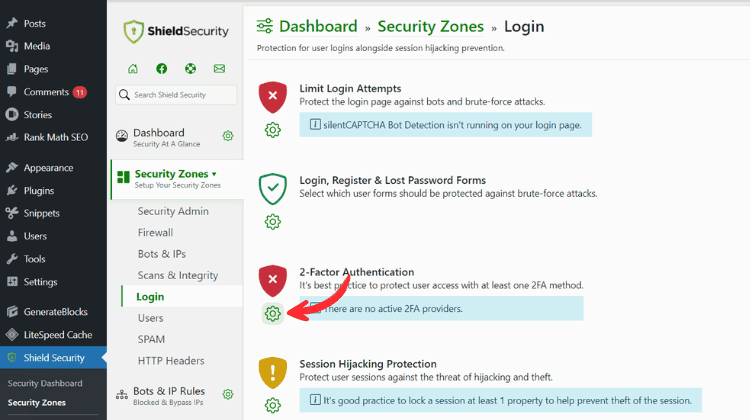
On the next page to configure 2-factor authentication, you’ll see different tabs for different methods of 2FA activation. For the first email method, just tick the checkbox. As soon as you do it, it will send you an email for verification. Verify it’s you and 2FA will be activated.

Another method to configure 2FA is through OTP. You can tick the checkbox for Google Authenticator. After saving changes, go to your user profile and scroll down to the bottom of the page. Here you’ll see a QR code to set up 2FA using the Google Authenticator app, just like we did in the Wordfence Security plugin.
Pros
-
Offers multiple methods for 2-factor authentication.
-
Comes with the Limit Login Attempts and Session Hijacking Protection.
-
All-in-one WordPress security plugin like Wordfence.
-
Comes with Firewall Protection and Malware Scan features.
Cons
-
Setting up 2FA for multiple methods can be complex.
-
Doesn’t have an SMS method for 2FA.
-
2FA backup codes are not visible on the dashboard.
3. miniOrange’s 2-Factor Authentication
If you are looking for a plugin solely made for two-factor authentication purposes, miniOrange’s 2-Factor Authentication plugin is the best option. While other plugins offer only one or two methods for 2FA, this plugin comes with different 2FA methods including Google Authenticator, OTP over SMS, OTP over Email, OTP over Telegram, and many more.
I personally tested this plugin on one of my blogs, the configuration is also very simple. Anyone can easily install and set the 2FA on their WordPress website via plenty of mediums. Let’s see how to set up 2FA using the miniOrange’s 2-Factor Authentication plugin.
Set up 2FA using miniOrange’s Two-Factor Authentication Plugin
Setting up 2FA using miniOrange’s 2FA plugin is the easiest task ever. First of all, install and activate the plugin. After activating it, the plugin will ask you to continue the setup wizard. It’s better to continue with the setup wizard so that you can set your preferences for inline registration, user roles, and grace period.
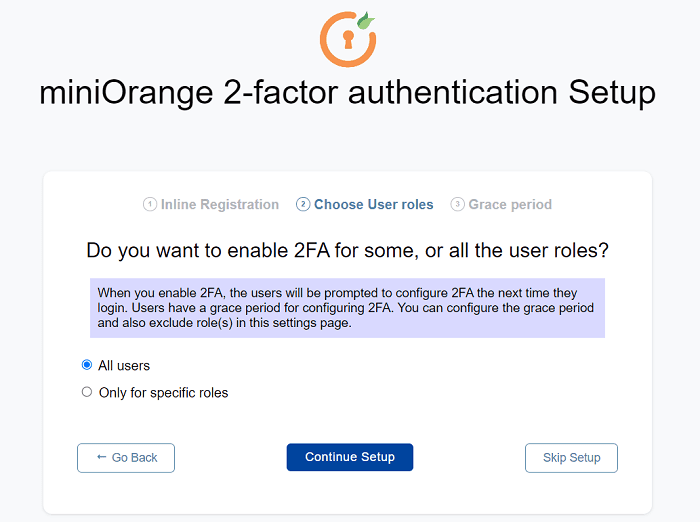
After you have completed the setup wizard, navigate to miniOrange 2-Factor > Two Factor Authentication from your WordPress dashboard, and click on the 2FA For Me tab. Here you’ll see multiple 2FA methods as mentioned before.
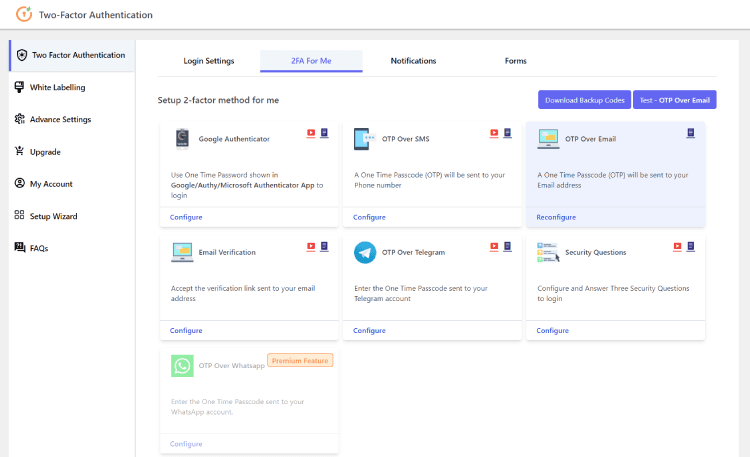
If you want to set up 2FA through an authenticator app, click the Configure link below the Google Authenticator method. Here, you can choose your desired authenticator app among Google Authenticator, Authy, Microsoft Authenticator, FreeOTP, and more.
The further process is absolutely the same as we did before in the Wordfence Security plugin. Just scan the QR code, enter the code from the authenticator app, and you’re all set.
For other methods like OTP Over SMS and OTP Over Email, you just need to enter your mobile number or email address to receive an OTP for verification, and you’re done. It’s just as simple as it looks.
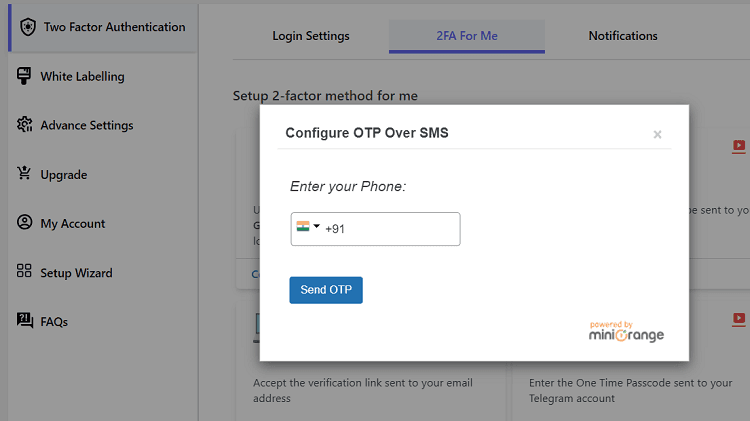
This is how you can easily set up the 2FA using different methods of the miniOrange 2-Factor authentication plugin.
Pros
-
Multiple 2FA methods including Authenticator App, SMS, Email, Security Questions, etc.
-
It is made solely for 2FA needs.
-
It has a very simple setup that non-technical users can also configure easily.
-
Its paid version comes with a passwordless login feature to log in directly using OTP.
-
The plugin provides active support right from the WordPress dashboard.
Cons
-
There is a limit on sending free SMS OTPs.
-
Many advanced features are locked behind the premium paywall.
-
Noticed compatibility issues with some caching and custom login plugins.
4. WP 2FA
Just like the miniOrange’s 2FA, this plugin also mainly provides 2FA solutions to WordPress users. WP 2FA plugin allows you to implement 2FA by two different mediums; using the authenticator app and email. For rare conditions when you do not anyhow receive the OTP, you can still log in to your WordPress website using the backup codes.
Setup 2FA Using WP 2FA Plugin
As soon as you install and activate the WP 2FA plugin on your WordPress website, a setup wizard will open in front of you. You can follow the instructions to set things up or just skip it to set up the plugin manually through plugin settings.
To manually set up the WP 2FA plugin, navigate to WP 2FA > 2FA Policies from your WordPress dashboard. Here, you will have to select the 2FA methods and other settings you need.

After that go to Users > Your Profile from the WordPress dashboard and scroll down to 2FA settings at the bottom of the page. Here, click on the Configure 2FA button and choose your preferred 2FA method in the popup.
The process of setting up 2FA using an authenticator app is the same as we described in the Wordfence Security app. For the Email 2FA, you just need to choose the email address on which you want the OTP and click the I’m Ready button. You will then receive an authentication code on your email to verify it. It’s that simple.
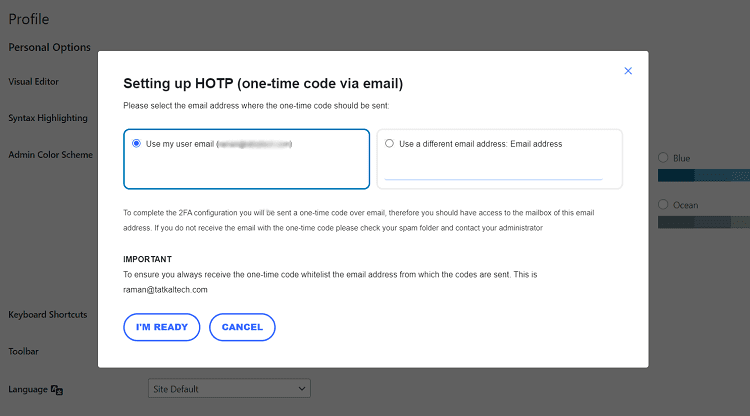
That’s all about setting up 2-factor authentication using the WP 2FA plugin. However, this plugin is solely made for 2FA purposes, it doesn’t contain other security features like firewall, malware scanning, etc.
Pros
-
The setup wizard makes it easy to set up 2FA.
-
Multiple 2FA methods including authenticator app, email, etc.
-
Backup codes are available to log in even without the OTP.
-
Compatible with almost all major 2FA applications.
-
You can hide the Remove 2FA button from user profile pages.
Cons
-
2FA via SMS is restricted behind the premium paywall.
-
Login with push notification is available with the premium version.
-
One-click login with the link in the email is available only with premium.
-
White labeling features are not available in the free version.
Read Also: How to Stop Spam Comments on WordPress?
That’s all guys! I’m sure these plugins will help you add an extra layer of security to your WordPress websites. I have tested all of these plugins on my personal level and then written their pros and cons based on my own testing.
Whether you’re looking for a full security suite or a plugin focused solely on 2FA, this short list of the 4 plugins has it all.
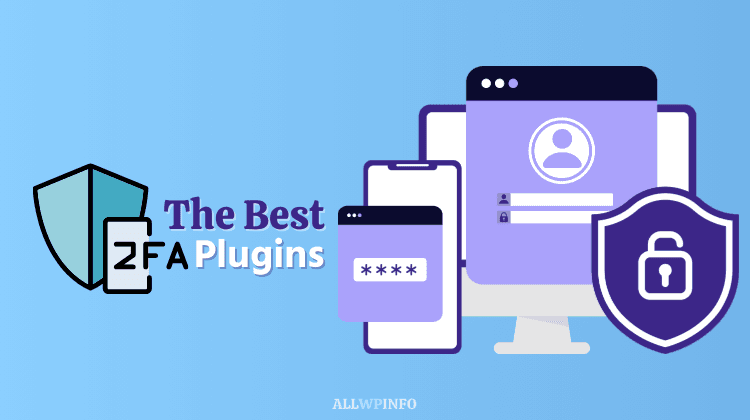
![5 Best Managed WordPress Hosting Providers [Tested] The best managed WordPress hosting providers.](https://allwpinfo.com/wp-content/uploads/2024/11/managed-wordpress-hosting-providers.webp)
![10 Must Have WordPress Plugins For Beginners [2024] Must have WordPress plugins](https://allwpinfo.com/wp-content/uploads/2023/10/must-have-wordpress-plugins.png)




